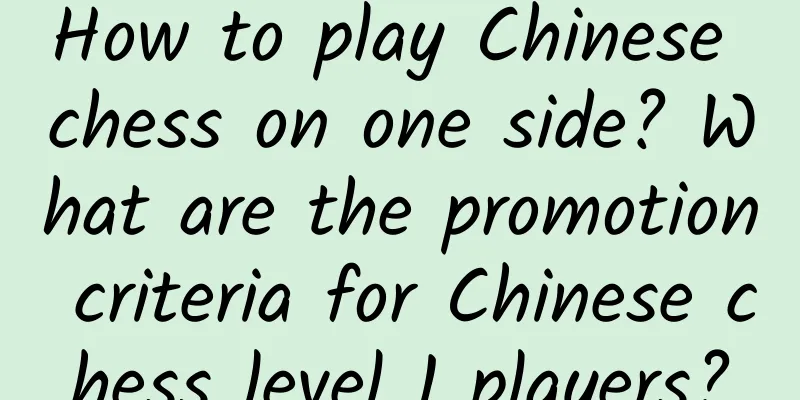How to play Chinese chess on one side? What are the promotion criteria for Chinese chess level 1 players?

|
I have introduced several issues of chess and international chess to my friends before. Today we continue with a new issue of chess. What we will share today is how to play one side in Chinese chess, what are the promotion standards for level 1 chess players in Chinese chess, and four-character idioms about chess. Do you find it interesting? Contents of this article 1. How to play Chinese chess on one side 2. What are the promotion criteria for Chinese chess level 1 players? 3. Four-character idioms about chess 1How to play Chinese chessThe rules of Chinese chess unilateral moves are as follows: 1. The general and the general can capture any piece except the pawn and the soldier. 2. The officials and the scholars can capture any chess piece except the king and the general. 3. Xiang and Xiang can capture any chess piece except Shi, Shi, Shuai and Jiang. 4. The chariot can capture any piece except the bishop, elephant, minister, scholar, general and king. 5. A horse can eat a cannon, a soldier or a pawn. 6. The cannon can capture any chess piece except the horse, but there must be a chess piece in between. 7. Soldiers and pawns can only capture the opponent's general and commander. 8. Except for the cannon, which can move multiple squares along the vertical or horizontal line when capturing chess pieces, other pieces can only move one square along the vertical or horizontal line each time. 2What are the promotion criteria for Chinese chess level 1 players?1. First-class chess player: 17th to 32nd place in the national individual competition. Top 6 in the individual competition of provinces, autonomous regions and municipalities directly under the central government. Top 3 in the industry sports association and the planned city. Top 3 in the national youth individual competition. 2. Second-level chess players: 32nd to 60th place in the national individual competition. 7th to 16th place in the individual competition of provinces, autonomous regions, and municipalities directly under the central government. 4th to 12th place in the industry sports association and the planned cities. Top 6 in the individual competition of provincial cities, regions, and autonomous prefectures. 4th to 12th place in the national junior individual competition. Top 3 in the junior individual competition of provinces, autonomous regions, and municipalities directly under the central government. 3. Level 3 players: 17th to 36th place in individual competitions in provinces, autonomous regions, and municipalities directly under the central government. 7th to 18th place in individual competitions in cities, regions, and autonomous prefectures under the jurisdiction of a province. 13th to 24th place in individual competitions in industry sports associations and cities with independent planning status. Top 8 in individual competitions in counties. 13th to 24th place in national junior individual competitions. 4th to 12th place in junior individual competitions in provinces, autonomous regions, and municipalities directly under the central government. 3Four-character idioms about chess1. Chuhe Hanjie: The river boundary between Chu and Han during the war. Later, the boundary between the two sides on the Chinese chessboard was written as "Chuhe Hanjie". It is also a metaphor for the front line of a general war. It is also called "Chujie Hanhe". 2. Sacrifice the rook to save the king: a tactic in chess games. It means sacrificing something more important to protect the most important. 3. Pawns crossing the river: According to the rules of chess, pawns can only move forward, not backward. After crossing the river, they can move sideways, which is more powerful. It is a metaphor for being able to move forward, not backward. 4. Sacrifice the Rook to Save the King: A chess term, which means that in certain struggles, in order to preserve the main characters, the responsibility is pushed onto the secondary characters. 5. Changing the general with a horse: A chess term. It refers to exchanging the opponent's general with a horse. It also refers to a major personnel change. |
<<: How many chess pieces are there? How to play chess and the rules
>>: Why is the egg yolk white? (Maybe the chicken feed lacks carotenoids)
Recommend
What is the problem of female nipple inversion?
Since many women wear very tight underwear during...
5 major "warning" symptoms of cataracts, this group of people should pay attention!
Cataracts, as a common eye disease, have become a...
A connection that shouldn't happen directly: cerebral vascular malformation
Author: Wang Shuo, Chief Physician, Beijing Tiant...
Why is my lower body itchy after sex?
Sexual life between men and women is a very commo...
What are the methods of prenatal diagnosis?
Many prenatal diagnosis methods are unfamiliar du...
Small "particles" are related to your health. Come to "Science Answers" to answer questions and get winter protection knowledge
As winter approaches, infectious diseases are at ...
Kidney patients who are afraid of "potassium" must learn to eat these foods
For many kidney patients, hyperkalemia is a probl...
What is the difference between fishy and foul-smelling vaginal discharge?
Disease is a very common situation in daily life....
Why do pregnant women always get angry?
If a pregnant woman always gets angry, it means t...
What causes uterine malformation?
The uterus is a key area for embryonic developmen...
What causes vaginal dryness during sex?
Some women have problems with their sex life, so ...
Ovulation bleeding ovulation test strip test results
Nowadays, women all know that if they have sex du...
What causes leucorrhea to be like tofu dregs?
Do you know why your leucorrhea is in the shape o...









